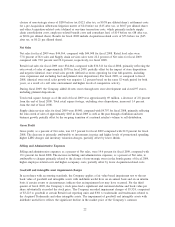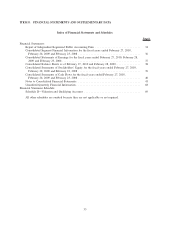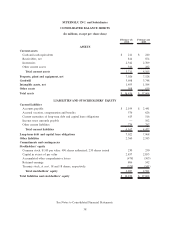Albertsons 2010 Annual Report Download - page 34
Download and view the complete annual report
Please find page 34 of the 2010 Albertsons annual report below. You can navigate through the pages in the report by either clicking on the pages listed below, or by using the keyword search tool below to find specific information within the annual report.The Company recognizes deferred tax assets and liabilities for the expected tax consequences of temporary
differences between the tax bases of assets and liabilities and their reported amounts using enacted tax rates in
effect for the year in which it expects the differences to reverse.
The Company’s effective tax rate is influenced by tax planning opportunities available in the various
jurisdictions in which the Company operates. Management’s judgment is involved in determining the effective
tax rate and in evaluating the ultimate resolution of any uncertain tax positions. In addition, the Company is
currently in various stages of audits, appeals or other methods of review with taxing authorities from various
taxing jurisdictions. The Company establishes liabilities for unrecognized tax benefits in a variety of taxing
jurisdictions when, despite management’s belief that the Company’s tax return positions are supportable,
certain positions may be challenged and may need to be revised. The Company adjusts these liabilities in light
of changing facts and circumstances, such as the progress of a tax audit. The effective income tax rate includes
the impact of reserve provisions and changes to those reserves. The Company also provides interest on these
liabilities at the appropriate statutory interest rate. The actual benefits ultimately realized for tax positions may
differ from the Company’s estimates due to changes in facts, circumstances and new information. As of
February 27, 2010 and February 28, 2009, the Company had $133 and $114 of unrecognized tax benefits,
respectively.
The Company records a valuation allowance to reduce the deferred tax assets to the amount that it is more-
likely-than-not to realize. Forecasted earnings, future taxable income and future prudent and feasible tax
planning strategies are considered in determining the need for a valuation allowance. In the event the Company
was not able to realize all or part of its net deferred tax assets in the future, the valuation allowance would be
increased. Likewise, if it was determined that the Company was more-likely-than-not to realize the net
deferred tax assets, the applicable portion of the valuation allowance would reverse. The Company had a
valuation allowance of $161 and $165 as of February 27, 2010 and February 28, 2009, respectively.
LIQUIDITY AND CAPITAL RESOURCES
Net cash provided by operating activities was $1,474, $1,534 and $1,732 in fiscal 2010, 2009 and 2008,
respectively. The decrease in cash provided by operating activities in fiscal 2010 compared to fiscal 2009 is
primarily attributable to decreased Net earnings, adjusted for the impact of non-cash impairment charges,
depreciation and amortization and LIFO expense, substantially offset by the changes in deferred income taxes
and operating assets and liabilities. The decrease in cash provided by operating activities in fiscal 2009
compared to fiscal 2008 is primarily attributable to changes in deferred income taxes.
Net cash used in investing activities was $459, $1,014 and $968 in fiscal 2010, 2009 and 2008, respectively.
The decrease in cash used in investing activities in fiscal 2010 compared to fiscal 2009 is primarily attributable
to lower capital spending and higher proceeds from the sale of assets. The increase in cash used in investing
activities in fiscal 2009 compared to fiscal 2008 is primarily attributable to lower proceeds from the sale of
assets.
Net cash used in financing activities was $1,044, $523 and $806 in fiscal 2010, 2009 and 2008, respectively.
The increase in cash used in financing activities in fiscal 2010 compared to fiscal 2009 is primarily attributable
to higher levels of debt reduction. The decrease in cash used in financing activities in fiscal 2009 compared to
fiscal 2008 is primarily attributable to higher levels of borrowing.
Management expects that the Company will continue to replenish operating assets with internally generated
funds. There can be no assurance, however, that the Company’s business will continue to generate cash flow at
current levels. The Company will continue to obtain short-term or long-term financing from its credit facilities.
Long-term financing will be maintained through existing and new debt issuances and its credit facilities. The
Company’s short-term and long-term financing abilities are believed to be adequate as a supplement to
internally generated cash flows to fund capital expenditures and acquisitions as opportunities arise. Maturities
of debt issued will depend on management’s views with respect to the relative attractiveness of interest rates at
the time of issuance and other debt maturities.
28
























